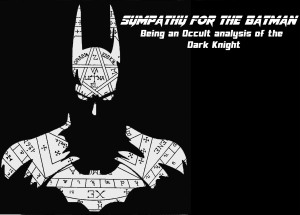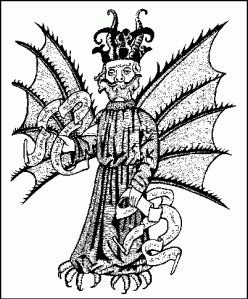 “Deep down, Clark’s essentially a good person… and deep down, I’m not.” – The Batman, Hush, DC Comics 2002-2003
“Deep down, Clark’s essentially a good person… and deep down, I’m not.” – The Batman, Hush, DC Comics 2002-2003
So, I admit it, some of my first childhood memories were acquiring the old Mego action figures of all of the Marvel and DC superheroes, and I have been into comics (I believe starting with a Giant Size Man-Thing from like, 1973) since I could read. (Funny note – that issue involved the demon Erthold, who was attempting to manifest on this plane through pretty heavily implied Sex Magick. Oh yeah, and a side story about Howard the Duck hunting down Bessie the Hellcow…) But my favorite was always the Batman. As a kid, the camp of the sixties classically bad TV show flew over my head, fortunately, but my interest in the character (and comics in general) would be resurrected in that great platinum age of the graphic novel, from the late 80’s, with such classics as The Watchmen, Sandman, The Killing Joke, Maus, Love and Rockets, and, of course, most of all, The Dark Knight Returns. This abstract-style mini-series featured such now familiar tropes as a dystopian Gotham City, hyper-violent gangs, a homicidally funny Joker, and a vicious vigilante with enough money and high tech gear to resume his “war” against crime after superheroes have been outlawed (another common plot element in many of the stories from this time). It would primarily influence the Batman mythos later in that he would be treated much more seriously in other media (that is, until Joel Shumacher put nipples on the batsuit) until finally we have the ultimate expression of our era’s modern Batman, the Academy Award™ winning billion dollar masterpiece The Dark Knight Trilogy.So why? What is so compelling about this character in the first place? Other than the usual aesthetics he possesses as a super heroic badass (which he kind of set the template for back in the day, when the character was conceived during the depression by Bill Finger and Tom Kane) the Dark Knight must have something going on in his makeup that has captured the public’s imagination for over half a century. Prior to composing this essay this author committed himself to some research into the academic side of the character and found some interesting takes on Mr. Wayne and his “Shadow”, as it were, usually taking on Batman from the perspective of Jungian psychology, Freudian Analysis, or, sometimes, classical mythology. Batman was treated as suffering from an unresolved Oedipal complex; he is separating his “Shadow” self, the rages and impulses left over from the unresolved traumatic stress of witnessing his parent’s death, into the avenging Dark Knight; he struggles against the political and economic system of his corrupt society, even as he is wealthy scion of its elite, making him a true hero of the people, such as the Scarlet Pimpernel, Robin Hood, The Count of Monte Cristo, etc.; but nowhere do we find a simple discussion of the basic symbolism that underlies the character. The Batman is broken down by most of the articles and abstracts, by fitting him into the theories, and not the other way around. This time, the author will attempt to redress this by showing how, as usual in Occultism, the keys to the meaning are hidden in plain sight.
“Without warning, it comes. Crashing through the window of your study. I have seen it before… somewhere. It frightened me as a boy… frightened me. Yes, father. I shall become a bat.” – Frank Miller, Batman: Year One
The silhouette of our subject is encased in darkness, a black cape webbed as a bat’s, a black cowl with long, horn-like ears that essentially makes him faceless. It is often said that his appearance would much more naturally belong to the super villain, and it is here that we see the first contrast with his DC Heroes counterpart, Superman, whose costume consists of bright primary colors, all associated with life (the S, the red cape, the blue, etc., etc., all great solar hero stuff, but I digresses…), whereas Batman’s appearance, his entire motif is nocturnal, the ninja, the special forces operative, with his cape and innumerable bat-references calling to mind several Gothic conceptions of the vampire myth. Again, all great stuff for Count Dracula or Darth Vader, not so much for the savior of Gotham City. The reason it works, the author believes, has something to do with the urban realities of 20th century America. Superman is who we would like to be, but Batman is who we are. But there is a deeper difference of sublime occult importance (remember, True Believers, that occult means “hidden”) – Superman is, despite his alien pedigree, of completely human (nay, perfectly human!) appearance; the Batman, by his very nature, is theriomorphic. That is, his profile combines human and animal features, as with a host of other later superheroes, gods (the Egyptian pantheon comes immediately to mind) and the angels and demons of the Western Mystery Tradition (the Goetia, for example). So what about the Bat makes it particularly applicable as an icon for justice? Well, the story goes that Batman’s creators were inspired originally by the Da Vinci designs for flying machines featuring bat-like wings, as well as other spooky avengers of the night such as the Shadow; but the profile evolved into something much more specific… In the beginning, however, the Bat connected our hero to the Underworld, to the supernatural plane, where justice could be served to the living (remember Bruce’s dead parents) by something representing the outside forces of nature, something that would inspire fear in the wicked. But as the character’s image was refined in the 1970’s after the camp 60’s series, his visage became highly stylized, but always darker, with dark blue giving way to black batsuits and the iconic ‘ears’ of the cowl becoming longer, pointier, almost like horns…
 As this “Dark Knight” scary Batman became dominant over the “Caped Crusader” style Bat-Man (Usually losing Robin in the process) the archetypes really began to solidify themselves. Since Frank Miller’s seminal work The Dark Knight Returns, the concept of the dark avenging Batman in contrast to the all-powerful sun god Superman has become commonplace, both characters becoming ambivalent commentary on the other in a modern world where any such extremes point to an inherent split within our society, within ourselves. (An old split, to be sure, but pushed to the extremes from time to time during crises) In our American society, we can have our all good, all powerful sun god Jesus (Superman), and all of the great things that come along with expansionist, consumerist based economics, but there is a price, a price paid during the Great Depression and our current societal woes, involving poverty, crime, injustice, corruption, and the decay of the spirit. If Jesus dominates our spiritual worldview as a nation (Christmas Jesus, if you take my meaning) and Superman is his comic book mythic interpretation, then the Devil, Satan, Old Scratch, Baphomet himself must, by dint of psychological necessity, dominate our spiritual mass “unconscious”. Satan in Christianity is a divided god, but in the comics, he has re-assumed his Old Testament duties of punishing the wicked, and is in fact no longer a devil or demon at all, but a natural totem in the image of Pan. With a cape. And a Batmobile. And Batarangs – you get the idea.
As this “Dark Knight” scary Batman became dominant over the “Caped Crusader” style Bat-Man (Usually losing Robin in the process) the archetypes really began to solidify themselves. Since Frank Miller’s seminal work The Dark Knight Returns, the concept of the dark avenging Batman in contrast to the all-powerful sun god Superman has become commonplace, both characters becoming ambivalent commentary on the other in a modern world where any such extremes point to an inherent split within our society, within ourselves. (An old split, to be sure, but pushed to the extremes from time to time during crises) In our American society, we can have our all good, all powerful sun god Jesus (Superman), and all of the great things that come along with expansionist, consumerist based economics, but there is a price, a price paid during the Great Depression and our current societal woes, involving poverty, crime, injustice, corruption, and the decay of the spirit. If Jesus dominates our spiritual worldview as a nation (Christmas Jesus, if you take my meaning) and Superman is his comic book mythic interpretation, then the Devil, Satan, Old Scratch, Baphomet himself must, by dint of psychological necessity, dominate our spiritual mass “unconscious”. Satan in Christianity is a divided god, but in the comics, he has re-assumed his Old Testament duties of punishing the wicked, and is in fact no longer a devil or demon at all, but a natural totem in the image of Pan. With a cape. And a Batmobile. And Batarangs – you get the idea.
“Batman is his hidden, demonic rage-filled side. The creature Batman creates is an absolutely sincere creature and one that he has to control but does so in a very haphazard way. He’s capable of enacting violence — and to kill — so he’s constantly having to rein himself in.” – Christian Bale
Was it Anton LaVey who described Batman as “The first Satanic superhero”? The imagery is all there – first, note that the Dark Knight is completely human, unlike the God-like Superman (identifying the Man and Beast); he is brilliant, the world’s greatest detective, and one of the most fearsome hand to hand combatants, to be sure, but without any superpowers other than his desire to avenge his parent’s murder and his extremely cool iconography. Many times, however, it is simply his presence which allows him to intimidate lesser thugs. His headquarters, known as the Batcave (continuing on with his usual compulsiveness in maintaining the “bat” theme) is a perfect corollary to the underworld, again, and the source of his strength. Better to rule in hell than serve in heaven, Bruce Wayne might say. In Batman Begins, director Christopher Nolan reflects some of the ideas from Frank Miller’s Year One with the fall into the well filled with bats, sparking a childhood phobia in the young Bruce Wayne, a fear he would later overcome and use to his benefit as Batman. But, in the same film, it is the bat imagery associated with Mefistofele that makes Bruce insist on leaving the opera early, which leads to his parents’ death. The theme of a bestial, supernatural component to the Batman persona plays out over and over again in the modern takes on the myth, from the Tim Burton films, through the DC Animated work with the character up until now with Nolan’s mature, realistic evolution of his psyche. This is necessary, as previously stated, to give a unity of image to the overall subconscious desire for justice on our part, a justice not borne out of the highest parts of the human psyche (Superman) but rather a more natural justice from the wildest parts of the world and ourselves, one that contrasts brutal violence (not killing in general, though…) with scientific exactitude, subtle deception with constant discipline. Yes, essentially that would be Pan again, the chaos and order of nature itself conceived as one. Which one is the real character, we may ask? Is he really Bruce Wayne, or Batman? Is there really no “Secret Identity”, just the “Superhero”? As the concept of superheroes relates in some fashion to the alteration of identities and consciousness experienced in initiation, or the Knowledge and Conversation process in general, the answer becomes clear – Batman is known amongst men and women as Bruce Wayne – but he is always the Dark Knight.

Kickass analysis bro! 🙂